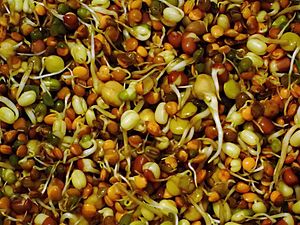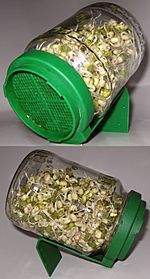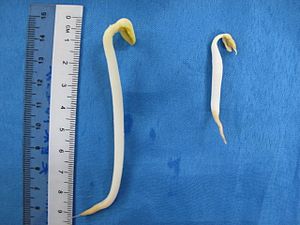Sprouting facts for kids


Sprouting is a natural process where seeds or spores start to grow. They put out tiny shoots, which are like their first baby leaves or stems. It's also when plants that are already growing make new leaves or buds.
In the world of nutrition, sprouting means making seeds grow just enough to eat them. People eat these sprouts raw or cooked. They are thought to be very healthy! The word "sprouting" can also mean when hair starts to grow, or when something new suddenly appears.
Contents
Seeds You Can Sprout
Almost any healthy seed can sprout. But remember, some sprouts should not be eaten raw. Always check if a sprout is safe to eat before trying it!
Bean sprouts are very popular around the world, especially in Asian cooking. They usually take about a week to grow fully. Sprouted beans are often more nutritious than the original beans. They also cook much faster!
Here are some common types of seeds used for sprouting:
- Beans and Peas (like the pea family):
* alfalfa * clover * fenugreek * lentil * pea * chickpea * mung bean * soya bean
- Grains (like grasses):
* oat * wheat * maize (corn) * rice * barley * rye
- "Fake" Grains (pseudocereals):
* quinoa * amaranth * buckwheat
- Oil Seeds (seeds that make oil):
* sesame * sunflower * almond * hazelnut * hemp * linseed * peanut
- Cabbage Family (Brassica):
* broccoli * cabbage * watercress * mustard * radish * arugula * turnip
- Parsley Family (Apiaceae) - often grown as tiny greens:
* carrot * celery * fennel * parsley
- Onion Family (Allium):
* onion * leek * green onion
- Other Veggies and Herbs:
Important Safety Tips for Sprouting
- Not all seeds can be eaten raw when sprouted! For example, sprouts from the nightshade family (like tomato, potato, or eggplant) and rhubarb are poisonous if eaten raw. Some can be cooked to remove toxins, but it's best to avoid them for sprouting.
- Use seeds meant for eating! Seeds sold for planting might have toxic chemicals on them. Always buy seeds specifically labeled for sprouting or human food. Some countries even require edible seeds to be heat-treated so they can't sprout.
How Seeds Sprout: The Process

Sprouting takes a few days. You can do it at home, or big companies do it on a large scale.
First, you rinse the seeds to clean off any dirt. Some seeds also make a slimy substance when wet, which you wash away. Then, you soak the seeds in water. This can be for 20 minutes to 12 hours, depending on the seed. Soaking helps the seeds absorb water and "wake up" from their resting state. After soaking, you drain the water. Then, you rinse the seeds regularly. This helps them start to grow, or sprout!
Sprouting at Home
For home sprouting, you soak the seeds, then leave them at room temperature (about 13 to 21 degrees Celsius). You can use many different containers. A simple glass jar with a mesh screen or cloth over the top works well. You can also buy special clear plastic sprouters with multiple levels. These let you grow different types of sprouts at the same time.
It's very important that your sprouting container lets water drain out. If sprouts sit in water, they will rot quickly. The seeds will swell up and start to sprout within a day or two.
Rinsing and Growing
You should rinse your sprouts two to four times a day. This keeps them moist and stops them from going bad. Each type of seed has its own best sprouting time. After about three to five days, most sprouts will be 5 to 8 centimeters long. This is when they are ready to eat!
If you let them grow longer, they will start to develop small leaves. Then they are called "baby greens." For example, sunflower baby greens are popular after 7 to 10 days. You can put sprouts in the refrigerator to slow down or stop their growth.
Why Sprouts Might Not Grow Well
Sometimes sprouts don't turn out right. Here are common reasons:
- Seeds were not rinsed well enough before soaking.
- Seeds were left in standing water after soaking.
- Seeds were allowed to dry out.
- The temperature was too hot or too cold.
- The equipment used was dirty.
- Not enough fresh air.
- The water used was not clean.
- The seeds were old or not good quality.
Light and Pressure for Sprouts
Mung beans can sprout in light or dark places. If they grow in the dark, they will be whiter and crunchier. This is how many bean sprouts sold in stores are grown. However, sprouts grown in partial sunlight might have more nutrients. Growing them in full sunlight is not a good idea, as they can get too hot or dry out.
You can also put a gentle weight on top of your sprouts in their container. This pressure can make them grow bigger and crunchier, like the ones you buy at the grocery store.
A simple way to sprout beans like lentils or azuki beans is in a colander. First, soak the beans in water for about 8 hours. Then, put them in the colander. Rinse them twice a day. You can eat these sprouted beans raw or cooked.
Sprouting is also used on a big scale for barley. This process is called malting. Malted barley is a key ingredient in making beer.
Many nuts, like almonds and peanuts, can also be soaked and started in their growth cycle. When eaten, these are often called "soaks" because the sprouts are still very tiny.
Images for kids
-
Sprouts sold as snacks during the Kumbh Mela festival.
-
Sprouts growing in a verrine (a type of glass container).
-
An automatic sprouter, like a small greenhouse.
See also
 In Spanish: Semillas germinadas para niños
In Spanish: Semillas germinadas para niños







